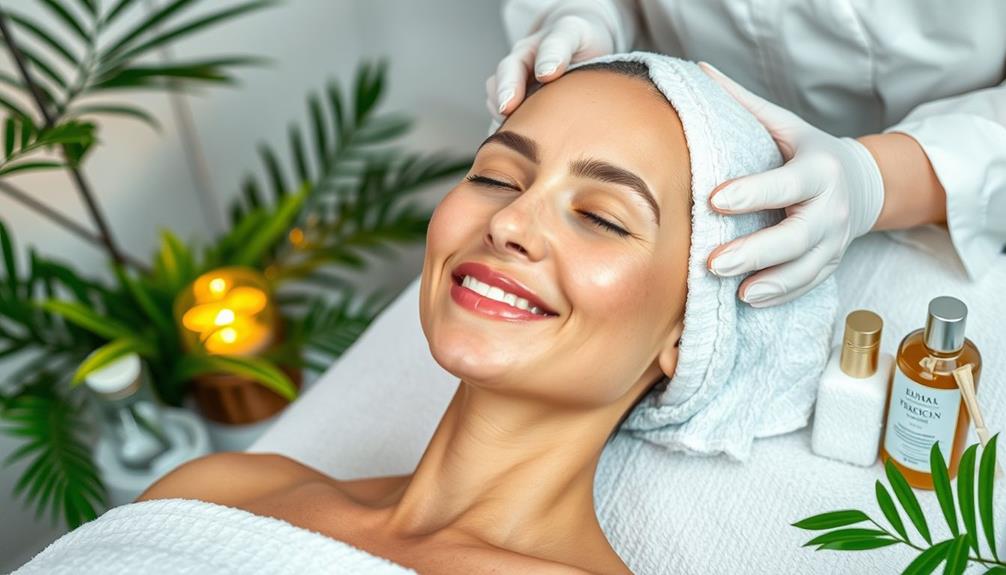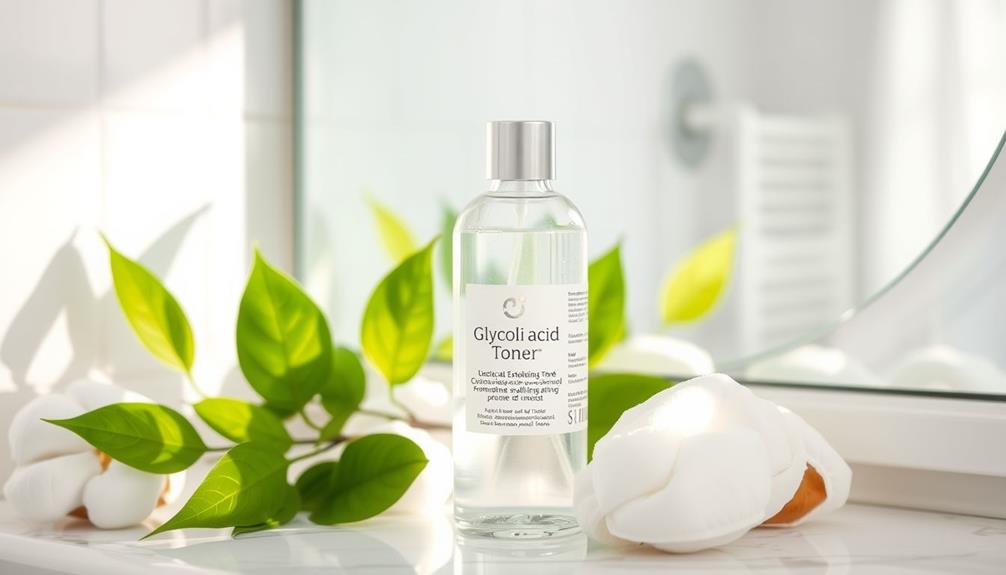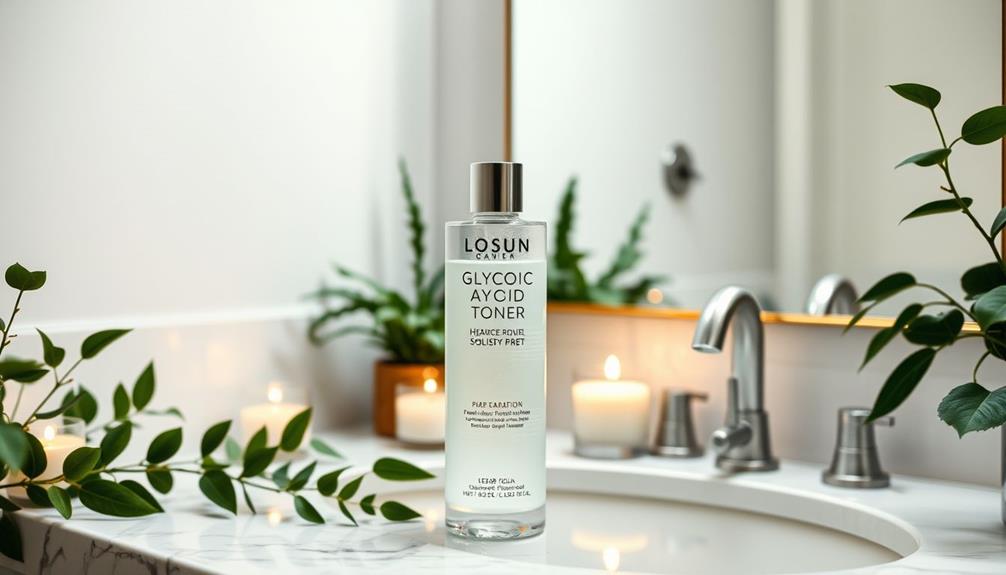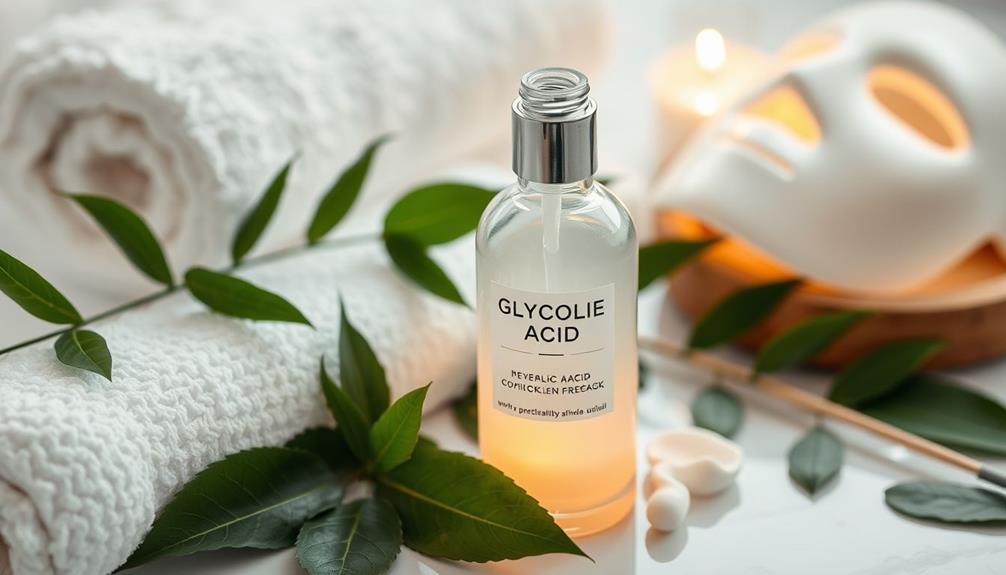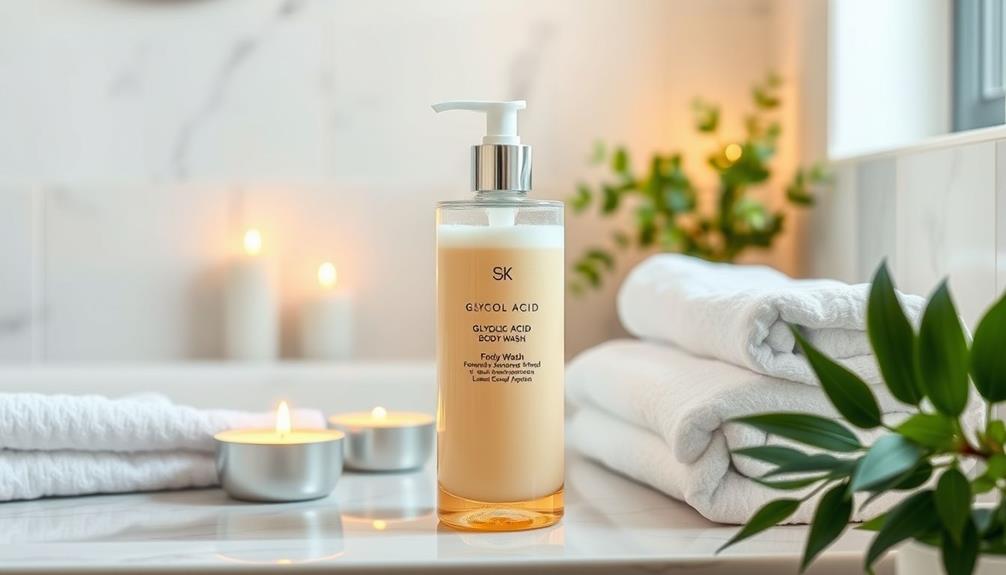Glycolic acid peels are amazing for rejuvenating your skin, addressing concerns such as acne, wrinkles, and uneven skin texture. This efficient procedure removes dead skin cells, increases collagen production, and stimulates cell renewal, unveiling smoother skin. Results can be seen in skin texture and tone after just one session, but a series of treatments can enhance the outcomes even more. While there may be some minor redness or peeling afterwards, the benefits typically outweigh the risks when you follow aftercare instructions. You will learn more about prepping and long-term maintenance options as you explore the advantages of glycolic acid peels.
Key Takeaways
- Glycolic acid peels exfoliate the skin, improving texture and promoting a youthful appearance by reducing fine lines and wrinkles.
- They effectively reduce hyperpigmentation and dark spots, leading to a more even skin tone through enhanced cell turnover.
- These peels help manage acne by preventing clogged pores and diminishing the appearance of acne scars.
- The procedure is quick, lasting under 30 minutes, with mild side effects like redness and peeling that typically resolve within a week.
What Is Glycolic Acid Peel?

A glycolic acid peel is a popular superficial chemical treatment that uses glycolic acid, an alpha-hydroxy acid derived from sugarcane, to effectively exfoliate your skin and enhance its texture.
This peel works by removing dead skin cells, promoting cell turnover, and revealing fresher skin underneath. It's particularly effective for addressing various skin issues such as acne, hyperpigmentation, fine lines, and enlarged pores.
Additionally, incorporating natural alternatives like essential oils can complement your skincare routine, as certain oils, such as lavender, promote emotional balance and can enhance overall wellness while you undergo treatments like peels natural alternatives to chemical products.
The procedure typically takes under 30 minutes, during which glycolic acid is applied to your skin for a few minutes before being neutralized.
Depending on the concentration, which can range from 20% to 70%, the level of exfoliation varies. Higher concentrations allow for deeper penetration but may require longer recovery times.
Regular treatments can lead to cumulative benefits, improving your skin's overall texture and tone.
One of the key advantages of glycolic acid peels is their ability to stimulate collagen production, helping to maintain your skin's elasticity and firmness.
With minimal downtime, these chemical peels provide a convenient option for enhancing your skin's appearance and addressing specific concerns.
Benefits of Glycolic Acid Peels

When you choose glycolic acid peels, you're on a path to smoother skin and a more even tone.
These treatments effectively target hyperpigmentation and help manage acne, giving your complexion a fresh boost.
Regular skincare routines, much like how environmental enrichment enhances a cat's well-being, can lead to ideal skin health.
With consistent use, you can enjoy significant improvements in skin texture and overall appearance.
Skin Texture Improvement
Glycolic acid peels deliver significant skin texture improvements by effectively exfoliating dead skin cells, resulting in a smoother and more even complexion. This potent acid penetrates deeply into the skin, stimulating collagen production, which enhances firmness and elasticity over time. As you undergo these treatments, you'll notice a reduction in fine lines and wrinkles, contributing to a youthful appearance.
Additionally, incorporating practices from self-exploration techniques can further enhance your overall well-being, reflecting positively on your skin. Moreover, glycolic acid peels help refine enlarged pores, making them less noticeable. This leads to a visibly improved skin texture and a decrease in acne breakouts.
Regularly using glycolic acid peels can transform your skin, with many patients reporting noticeable improvements in texture and radiance after just one session. However, ideal results typically arise from a series of peels tailored to your skin's needs.
Incorporating glycolic acid into your skincare routine not only addresses surface concerns but also promotes long-term skin health. By enhancing skin texture, you're setting the stage for a more radiant complexion and increased confidence in your skin's appearance. It's an effective choice for anyone looking to rejuvenate their skin and minimize imperfections.
Hyperpigmentation Reduction
Achieving a more even skin tone is another considerable benefit of glycolic acid peels, as they effectively reduce hyperpigmentation. By promoting cell turnover, glycolic acid helps to fade dark spots and improve overall skin clarity. Its small molecular structure allows for deeper penetration into the skin, making it particularly effective for stubborn hyperpigmentation issues like melasma. Additionally, incorporating natural remedies like essential oils for skin care can further enhance your skin's appearance and health.
With regular glycolic acid peel treatments, you can experience a noticeable improvement in skin clarity and brightness. These peels not only target existing dark spots but also help prevent new ones from forming. If you're dealing with post-inflammatory hyperpigmentation, especially after acne, glycolic acid peels can considerably decrease its appearance, leading to a more uniform skin tone.
Incorporating glycolic acid peels into your skincare regimen can also enhance the effectiveness of other topical treatments aimed at reducing hyperpigmentation. By allowing better absorption of active ingredients, these peels create a synergistic effect that amplifies results. As you commit to this treatment, you'll likely find your skin looking brighter and more radiant, with a marked reduction in hyperpigmentation.
Acne Management Benefits
For those struggling with acne, glycolic acid peels offer a powerful solution by effectively exfoliating the skin and preventing clogged pores. By promoting cell turnover, these peels not only help reduce breakouts but also improve the appearance of acne scars. When integrated into your skin care routine, glycolic acid enhances the effectiveness of other treatments, allowing deeper penetration of exfoliating cleansers and topical products.
Here's a quick overview of the benefits:
| Benefit | Description |
|---|---|
| Exfoliation | Removes dead skin cells, preventing clogged pores. |
| Diminished Acne Scars | Promotes skin renewal, fading the appearance of scars. |
| Enhanced Treatment Absorption | Improves efficacy of topical acne treatments. |
Regular use of glycolic acid peels can lead to noticeable improvements in your skin condition, enhancing clarity and tone. Additionally, by inhibiting melanin production, these peels can help reduce post-inflammatory hyperpigmentation associated with acne, giving you a more even complexion. If you're looking for a reliable method to manage acne, consider incorporating glycolic acid peels into your routine.
How Glycolic Acid Works
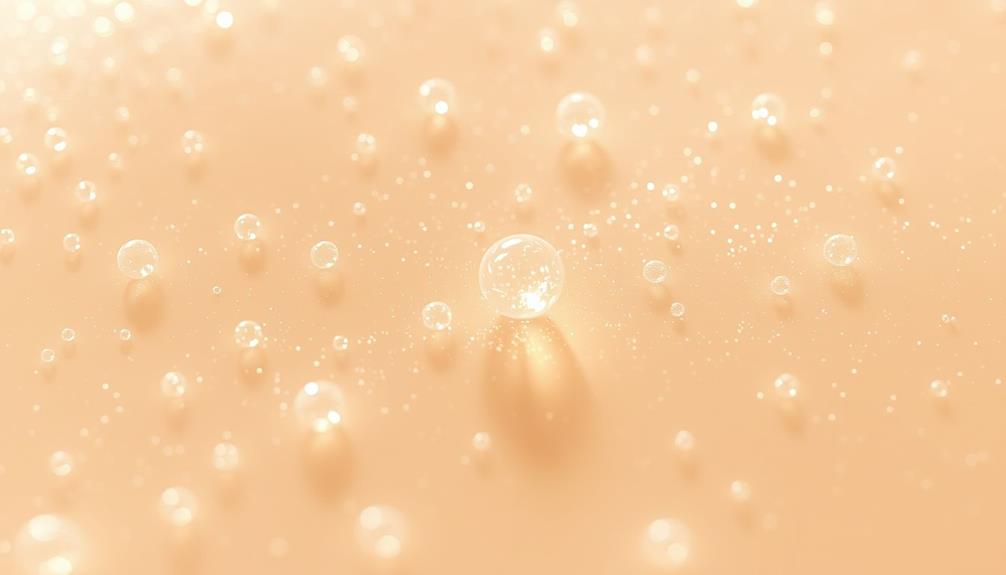
Utilizing its small molecular size, glycolic acid penetrates deep into the skin, effectively breaking down the bonds that hold dead skin cells together. This exfoliating action promotes cell turnover, revealing smoother and brighter skin underneath.
As you use glycolic acid, you'll notice a significant improvement in your skin texture, as it helps to slough away the outer layer of dead skin. Additionally, incorporating Rooibos tea benefits into your routine may enhance your skin health due to its high flavonoid content, complementing the effects of glycolic acid.
Glycolic acid is particularly effective for addressing hyperpigmentation. By inhibiting melanin production, it can reduce dark spots and even out your skin tone. Additionally, this powerful acid stimulates collagen production, enhancing your skin's firmness and reducing the appearance of fine lines.
If you struggle with acne, glycolic acid is also beneficial as an acne treatment. Its water-soluble nature allows it to dissolve excess sebum and prevent clogged pores, reducing the likelihood of breakouts.
Preparation for a Glycolic Acid Peel

To prepare for your glycolic acid peel, you'll need to follow some important pre-treatment guidelines.
It's essential to optimize your skin condition by avoiding exfoliating products and sun exposure in the week leading up to the treatment.
Additionally, guaranteeing a calm and serene environment, similar to a cozy cottagecore home office, may help reduce overall stress, which can positively impact your skin.
Consulting with a dermatologist can help ascertain your skin is ready and reduce any risk of irritation.
Pre-Treatment Guidelines
Before undergoing a glycolic acid peel, you'll want to stop using exfoliating products and consult with a dermatologist to guarantee your skin is ready for the treatment. Following these pre-treatment guidelines will help minimize irritation and enhance your results.
First, avoid all forms of exfoliation, including products containing AHAs, BHAs, and retinoids, for at least one week before the peel. This step reduces the risk of skin sensitivity during the procedure.
It's also important to avoid sun exposure and tanning in the week leading up to the treatment. Instead, use a broad-spectrum sunscreen to protect your skin.
In the days prior to your peel, consider using a gentle cleanser and hydrating your skin with a mild moisturizer. This can help prepare your skin barrier, making it more resilient for the treatment.
Additionally, refrain from waxing or any hair removal methods on the treatment area for at least a week.
Skin Condition Optimization
Optimizing your skin condition is essential for achieving the best results from a glycolic acid peel. Start by consulting with a dermatologist who can provide personalized advice based on your unique skin type and sensitivity.
For at least one week before your treatment, avoid all forms of exfoliation, including products with AHAs, BHAs, and retinoids. This step minimizes the risk of skin irritation and prepares your skin for the peel.
Prior to the treatment, practice good hygiene. Cleanse your skin thoroughly using a gentle cleanser to remove excess oils and impurities.
It's also vital to stop using harsh skincare products, particularly those with high alcohol content or fragrances, as they can exacerbate irritation.
Maintaining adequate hydration and a balanced diet in the days leading up to the peel will support your skin's health and resilience.
Treatment Process Overview

The treatment process starts with cleansing your skin to eliminate impurities and excess oils before applying the glycolic acid peel. This initial step guarantees that the peel can work effectively on your skin without any barriers.
Once your skin is prepped, the glycolic acid is applied for a specific duration—typically between 2 to 5 minutes—depending on the concentration of the acid and your skin condition. During this time, you might feel mild tingling or a slight burning sensation. After the application, the peel is neutralized to halt the chemical reaction and minimize potential irritation. The entire appointment usually lasts under 30 minutes.
Post-treatment care is essential to promote recovery and minimize skin damage. Following the procedure, it's important to use gentle moisturizers and maintain strict sun protection. Here's a quick overview of the treatment process:
| Step | Description |
|---|---|
| Cleansing | Remove impurities and oils |
| Application | Apply glycolic acid for 2-5 minutes |
| Neutralization | Stop the peel's action |
| Post-treatment care | Use moisturizers and sun protection |
Following these steps will help guarantee you achieve the best results.
Expected Results and Outcomes

After just one session, you can expect to see noticeable improvements in your skin tone and texture, especially in reducing hyperpigmentation and fine lines. Many people report brighter, more radiant skin almost immediately, thanks to the deep exfoliation provided by the glycolic acid peel.
For best results, consider a series of three to six treatments, which can further enhance your skin's appearance, smooth out acne scars, and improve skin firmness over time.
The expected results can vary based on the glycolic acid concentration used during the peel. Higher concentrations, up to 70%, offer deeper exfoliation and more dramatic improvements, but they may also require longer recovery periods.
While you might experience a mild tingling sensation during the procedure, side effects include temporary redness and peeling, which usually last about 7-10 days.
With regular treatments, you'll likely see ongoing improvements in skin elasticity and firmness, making your skin feel rejuvenated. It's important to follow aftercare instructions to maintain these results and protect your newly treated skin.
Side Effects and Risks
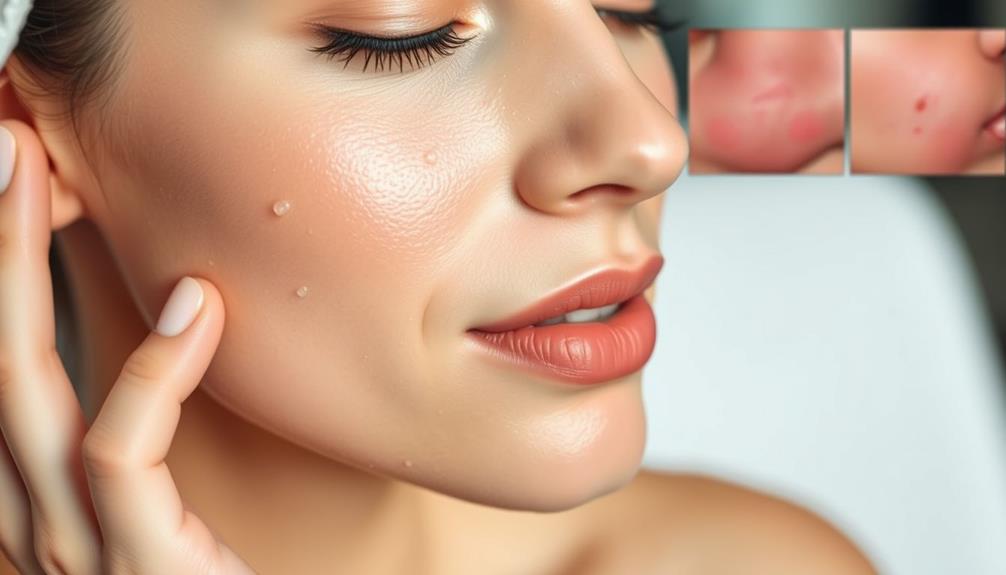
When considering a glycolic acid peel, it's important to be aware of potential side effects.
You might experience common issues like redness and peeling, as well as heightened skin sensitivity.
Additionally, there's a risk of hyperpigmentation, particularly if you have darker skin or a history of skin sensitivity, so following post-peel care is essential.
Common Side Effects
Common side effects of glycolic acid peels include redness, mild stinging, and peeling, but these typically fade within a week.
You might notice some minor skin irritation right after the procedure, especially if you have sensitive skin. The degree of these reactions often depends on the concentration of glycolic acid used; higher concentrations can lead to more pronounced side effects.
During the healing process, it's important to be gentle with your skin. Avoid harsh scrubs or exfoliants, as they can exacerbate irritation. In some cases, overuse or using high-strength glycolic acid can increase the risk of more severe issues like blistering or scarring.
Sun sensitivity may also heighten after your peel, so diligent sun protection is vital. Applying sunscreen and wearing protective clothing will help prevent any further damage.
If you have existing skin conditions or active infections, it's wise to consult with a dermatologist before proceeding with a glycolic acid peel, as these factors can increase the likelihood of adverse reactions.
Knowing these common side effects will help you better prepare for your experience and manage your skin effectively.
Skin Sensitivity Concerns
Skin sensitivity is a significant concern following glycolic acid peels, especially for those with pre-existing conditions or sensitive skin. You might experience common side effects like redness, mild stinging, and dryness in the days post-peel. These typically resolve within a few days but can lead to peeling or flaking that lasts from 7 to 10 days, depending on the peel's strength.
If you have sensitive skin or active infections, it's important to consult a dermatologist before undergoing treatment. They can help assess your skin's condition and recommend the appropriate peel strength. Overusing glycolic acid or opting for high concentrations (above 30%) can lead to more severe adverse reactions, such as blistering and scarring.
Additionally, proper sun protection is essential after your peel. Glycolic acid can heighten your skin sensitivity to UV rays, increasing your risk of sunburn and other pigmentation changes.
Risk of Hyperpigmentation
Hyperpigmentation can be a concerning side effect of glycolic acid peels, particularly if you don't take proper sun protection measures afterward. This risk is especially pronounced for individuals with darker skin types, who are more susceptible to post-inflammatory hyperpigmentation.
If you undergo a glycolic acid peel, it's essential to monitor your skin's reaction closely. If it shows signs of irritation, you may need to adjust your post-peel care routine.
To minimize your chances of developing hyperpigmentation, adhere strictly to post-peel care instructions. This includes the consistent application of broad-spectrum sunscreen, ideally with an SPF of 30 or higher. Sun exposure can exacerbate discoloration, so shielding your skin from harmful UV rays is critical in the days and weeks following your treatment.
Overusing high-strength glycolic acid peels can also lead to excessive irritation, further increasing hyperpigmentation risks. Always consult a skincare professional to determine the right strength and frequency for your skin type.
Aftercare Instructions
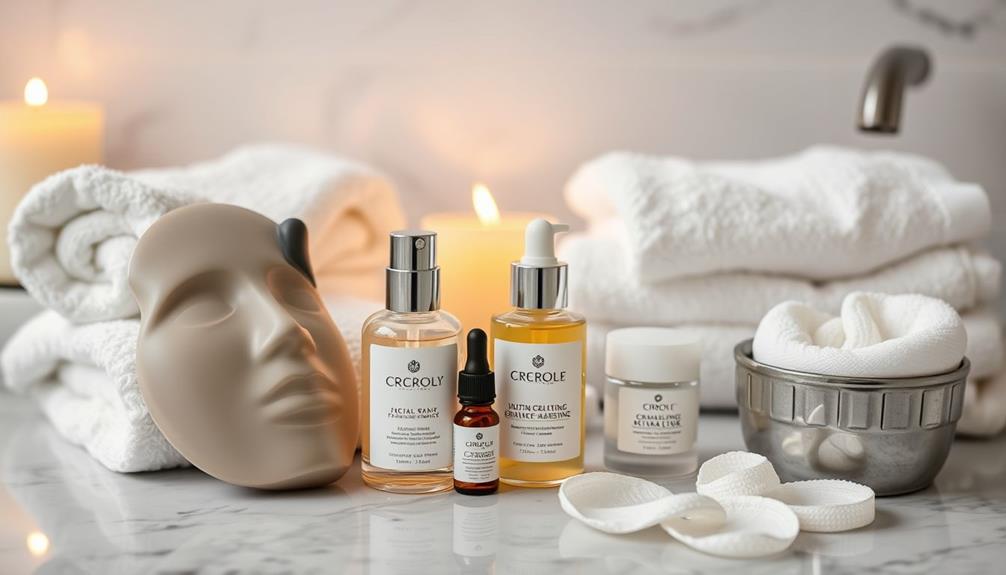
After your glycolic acid peel, it's important to follow specific aftercare instructions to guarantee your skin heals properly and achieves the best results.
Start by avoiding exfoliating products and harsh ingredients for at least a week. This allows your skin barrier to recover without additional irritation. Instead, focus on using hydrating products that contain ceramides, hyaluronic acid, and peptides to keep your skin moisturized.
Minimize direct sun exposure, and make certain to apply a broad-spectrum sunscreen with at least SPF 30 daily. This protects your skin from UV damage, which is vital after a peel.
For the next few days, avoid swimming pools, hot tubs, and intense workouts to prevent irritation and excessive sweating on the treated area.
Keep an eye out for signs of irritation, like excessive redness or peeling. If you notice anything concerning, don't hesitate to consult your dermatologist for guidance.
Comparing Professional and At-Home Peels

When considering glycolic acid peels, you might wonder about the differences between professional treatments and at-home options. Here's a breakdown to help you decide:
- Concentration of Glycolic Acid: Professional glycolic acid peels usually contain concentrations ranging from 30% to 70%, while at-home peels typically have lower concentrations of 10% to 20%. This makes professional treatments more potent and effective.
- Customization: Dermatologists can customize the peel strength and treatment plan based on your specific skin needs, ensuring ideal results. In contrast, at-home peels are generally a one-size-fits-all solution.
Ultimately, if you're looking for faster and more noticeable results, professional glycolic acid peels might be the way to go. However, if you prefer a gentler approach with more frequent use, at-home peels could be suitable for you. Just weigh your options based on your skin type and desired outcomes!
Long-Term Skin Care Considerations
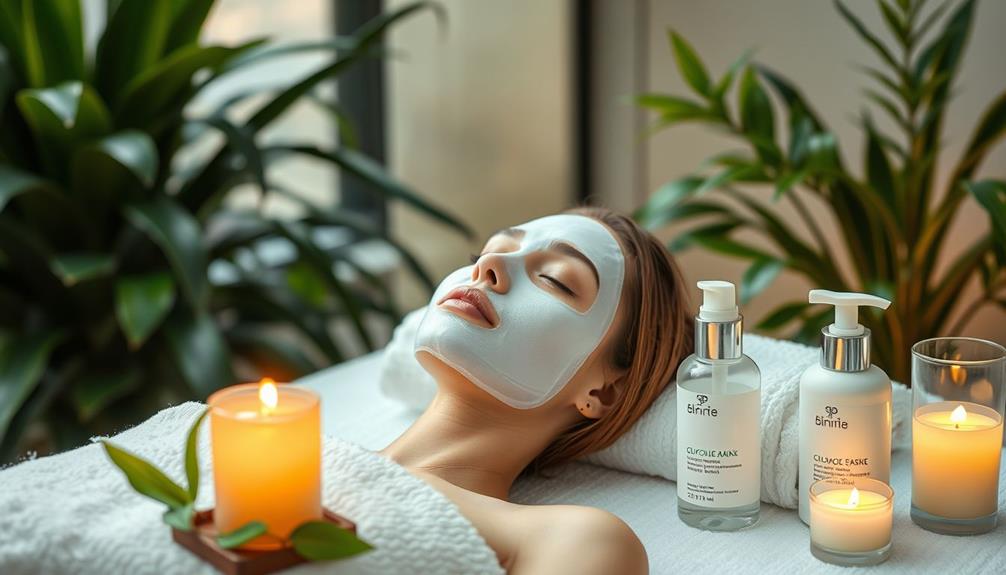
To maintain the benefits of glycolic acid peels, it's important to contemplate long-term skin care practices that support ongoing skin health and resilience. Regular use of glycolic acid peels can improve your skin texture and tone, but it's essential to adopt a consistent regimen afterward.
First, always apply sunscreen daily. Since glycolic acid can increase sun sensitivity, protecting your skin from UV damage is critical.
Next, focus on hydration. Incorporate moisturizers enriched with ceramides and hyaluronic acid to help strengthen your skin barrier, ensuring the best recovery and appearance after your peels.
Don't forget to monitor your skin condition regularly. This allows you to adapt your skin care routine as needed and address any emerging concerns before they escalate.
Lifestyle factors also play a significant role in skin health; maintain a balanced diet, stay hydrated, and avoid smoking to maximize the benefits of glycolic acid treatments.
Incorporating these long-term skin care considerations will help you maintain the results of your glycolic acid peels, ensuring your skin remains healthy and radiant.
Frequently Asked Questions
What Do I Need to Know Before Taking Glycolic Acid?
Before taking glycolic acid, you need to avoid other exfoliants and retinoids for a week. Be aware of potential redness and peeling, and always apply broad-spectrum sunscreen afterward to protect your sensitive skin.
What Are the Benefits of a Glycolic Acid Peel?
A glycolic acid peel brightens your complexion, reduces fine lines, and evens skin tone. It helps with acne scars and boosts collagen production. Regular treatments can keep your skin radiant and minimize breakouts.
What to Avoid When Using Glycolic Acid?
You might think it's okay to mix products, but avoid combining glycolic acid peels with other exfoliants. Also, steer clear of using them if you have active skin conditions or a history of allergic reactions.
How Do You Get the Best Results From Glycolic Acid?
To get the best results from glycolic acid, prep your skin by avoiding exfoliants, maintain a consistent peel schedule, prioritize post-peel care, and monitor your skin's reactions for ideal effectiveness and comfort.
Conclusion
To summarize, a glycolic acid peel can be a game-changer for your skin, delivering a fresh, radiant look.
Remember, "you reap what you sow" – investing in proper preparation and aftercare guarantees you get the best results.
Whether you choose a professional treatment or an at-home option, understanding the process and benefits will help you achieve your skin goals.
So, embrace the journey and enjoy the transformation!

